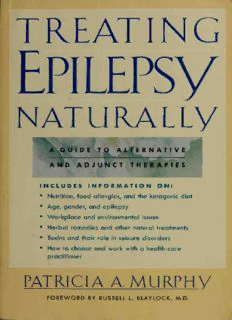
Treating Epilepsy Naturally . A Guide to Alternative and Adjunct Therapies PDF
Preview Treating Epilepsy Naturally . A Guide to Alternative and Adjunct Therapies
TREATING y leps EJPI NATURALLY AG UIDE TO ALTERNATIVE ADJUNCT THERAPIES A N D INCLUDES INFORMATION ON: • Nutrition, food allergies, and the ketogenic diet • Age, gender, and epilepsy • Workplace and environmental issues • Herbal remedies and other natural treatments • Toxins and their role in seizure disorders • How to choose and work with a health-care practitioner MURPH Y PATRICIA A. FOREWORD BY RUSSELL BLAYLOCK, M.D. L. Cat •/"'»' '•'- t TREATING LEPSy EPI NATURALLY AGUIDE TO ALTERNATIVE AND ADJUNCT THERAPIES MURPHY PATRICIA A. FOREWORD BY RUSSELL L. BLAYLOCK, M.D. Keats Publishing Chicago New York San Francisco Lisbon London Madrid Mexico (,'i/y Milan New Delhi SanJuan Seoul Singapore Sydney Toronto ipMcGrawHill LibraryofCongressCataloging-in-PublicationData Murphy,PatriciaA., 1951- Treatingepilepsynaturally:aguidetoalternativeandadjuncttherapies/ PatriciaA.Murphy, p. cm. Includesindex. ISBN0-658-01379-3 1. Epilepsy—Alternativetreatment. 2. Naturopathy. I. Title. RC372.M87 2001 616.8'53-dc21 2001029778 Copyright©2002byPatriciaA.Murphy. Allrightsreserved.PrintedintheUnitedStates ofAmerica.Exceptaspermitted undertheUnitedStatesCopyrightActof1976,nopartof thispublicationmaybereproducedordistributedinanyformorbyanymeans,orstored inadatabaseorretrievalsystem,withoutthepriorwrittenpermissionofthepublisher. 3 4 5 6 7 8 90 DOC/DOC 09876543 ISBN0-658-01379-3 Coverdesign byBillStanton/Stanton Design Coverillustration byKathyObringer Interiordesign byjeanetteWojtyla McGraw-Hillbooksareavailableatspecialquantitydiscountstouseaspremiumsand salespromotions,orforuseincorporatetrainingprograms.Formoreinformation, please writetotheDirectorofSpecialSales,ProfessionalPublishing,McGraw-Hill,TwoPenn Plaza, NewYork,NY10121-2298.Orcontactyourlocalbookstore. Thisbookisprintedonacid-freepaper. ForJesse Sinclair Digitized by the Internet Archive 2012 in http://www.archive.org/details/treatingepilepsyOOpatr Contents Forewordby RussellL. Blaylock, M.D. vii Preface xi Acknowledgments xiii part The Hidden Disorder i chapter i A Monster Beside Myself My Story 3 CHAPTER 2 Epilepsy HistoricalPerspectives 15 chapter 3 Understanding the Nature of Epilepsy 23 chapter 4 The Usual Route Diagnosis andTreatment 47 part Nutrition 11 chapter 5 Food Allergies and Sensitivities 73 chapter 6 Foods That Harm 87 chapter 7 Foods That Heal 109 chapter 8 The Ketogenic Diet 129 chapter 9 The Power of Herbs 139 vi Contents part in Listening to Your Body chapter 10 Controlling Your Brain Waves 153 chapter 11 Body Therapies 175 chapter 12 How Neurotoxins Affect Our Nervous System 187 part iv Age, Gender, andEpilepsy chapter 13 Children and Epilepsy 201 chapter 14 Women and Epilepsy 219 chapter 15 Men and Epilepsy 233 chapter 16 Epilepsy and the Elderly 239 part v Creating a Supportive Environment chapter 17 Communicating and Nurturing 249 chapter 18 The World ofWork Being Competentand Conscientious 263 chapter 19 How to Choose and Work with a Health-Care Practioner 273 chapter 20 Summing Up 281 Resources 285 Notes 299 Index 317 Foreword One of the most devastating and disturbing things that can beset a human being is the loss of control of one's nervous system. Author Pat Murphy tells us from firsthand experience what it is like to have your life torn apart by epilepsy. References to epilepsy are found as farback as recorded human history. While there is no question that we have come very far in understanding the disorder, our treatment still leaves much to be desired. In all areas of medicine, I have observed an enormous gap between what we learn through our scientific studies and how we applythat knowledge. TreatingEpilepsyNaturallyprovides the reader with a tremendous amount of scientific information concerning epilepsy, especially in the area of research that has remained untapped by conventional medicine. Medical care has changed drastically over the past ten years. Patients, dissatisfiedwith how they are being treated by the medical profession, have decided to seek answers on their own. What we are finding is that in many cases the patients learn more about their dis- ease than even the expert, a phenomenon that has been greatly enhanced by the Internet. Oftentimes when patients enter our offices, we find that they have already researched their illness and Vll viii Foreword the lesser-known treatment options. They also know all about the medications that are beingused alongwith their complications. With this base ofknowledge patients have grown dissatisfiedwith the pat answers their physicians frequently give them. For example, when they ask about using a special nutritional supplement that research has shown to be helpful in their condition, they are often told, "There is no evidence that that works," or "That product can be dangerous and possibly interfere with your treatment." What most patients don't knowis thatwhen their doctors make such statements, theyoften have no ideawhat they are talking about. In most cases they know little or nothing about the research con- cerning the use of the supplement and have little or no knowledge concerning the actual pathophysiology of the condition they are treating. Doctors in general have difficulty with biochemistry in medical school. Treatment of difficult-to-control conditions, such as epilepsy, requires an intimate knowledge of physiology and bio- chemistry. All medical conditions occur on a molecular level and involve numerous, often complex processes. If your doctors do not understand these molecular events, how can they efficiently treat your disorder? In addition to this lackofknowledge, doctors often suffer from manipulation by their financiers. Most doctors are trained in med- ical universities that receive their major financing from pharmaceu- tical companies. As a result, they are oriented toward pharmaceutical treatment of diseases. Make no mistake, pharmaceutical drugs have made a major contribution to our health, but they have also created a whole new kind of disease, one that can be fatal, called iatrogenic diseases. These are disorders caused by the treatment itself. More than five hundred thousand people ayear suffer major and even fatal complications from pharmaceutical drugs. In comparison, fewer than two hundred fifty thousand people suffer from complications from taking natural products, and most of these are minor.
